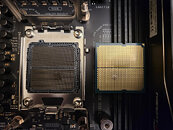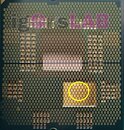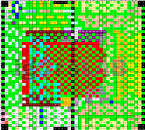- Joined
- Oct 9, 2007
- Messages
- 47,175 (7.56/day)
- Location
- Hyderabad, India
| System Name | RBMK-1000 |
|---|---|
| Processor | AMD Ryzen 7 5700G |
| Motherboard | ASUS ROG Strix B450-E Gaming |
| Cooling | DeepCool Gammax L240 V2 |
| Memory | 2x 8GB G.Skill Sniper X |
| Video Card(s) | Palit GeForce RTX 2080 SUPER GameRock |
| Storage | Western Digital Black NVMe 512GB |
| Display(s) | BenQ 1440p 60 Hz 27-inch |
| Case | Corsair Carbide 100R |
| Audio Device(s) | ASUS SupremeFX S1220A |
| Power Supply | Cooler Master MWE Gold 650W |
| Mouse | ASUS ROG Strix Impact |
| Keyboard | Gamdias Hermes E2 |
| Software | Windows 11 Pro |
AMD Ryzen 7000X3D processors are prone to irreversible physical damage if CPU overclocking is attempted at some of the higher VDDCR voltages (the main power domain for the CPU cores). A Redditor who goes by Speedrookie, attempted to overclock their Ryzen 7 7800X3D, leading to an irreversible failure. The motherboard socket and the processor's land-grid contacts, show signs of overheating damage caused by the contacts melting from too much current draw.
A Ryzen 7000X3D processor features a special CPU complex die (CCD) with stacked 3D Vertical Cache memory. This cache die is located in the central region over the CCD where its 32 MB on-die L3 cache is located, while the difference in Z-height of the stacked die is filled up by structural silicon, which sit over the regions of the CCD with the 8 "Zen 4" CPU cores. It stands to reason that besides having an inferior thermal transfer setup to conventional "Zen 4" CCDs (without the 3DV cache), the CCD itself has a higher power-draw at any given clock-speed than a conventional CCD (since it's also powering the L3D). This is the main reason why overclocking capabilities on the 7000X3D processors are almost non-existent, and the processor's power limits are generally lower than their regular Ryzen 7000X counterparts. Attempting to dial up voltage kicks up the perfect storm for these processors.



Igor's Lab posted a detailed analysis of the region of the Socket AM5 land-grid most susceptible to a burn-out in the above scenario. The central region of the LGA has 93 pins dedicated to the VDDCR power domain, dispersed in a mostly checkered pattern, toward the center of the land-grid. Igor isolated 6 of these VDDCR pins in particular, which are most prone to physical damage, as they are located in a region below the CCD that sees it sandwiched between the L3D (stacked 3D Vertical cache die), and the fiberglass substrate below. Apparently, AMD's thermal and electrical protection mechanisms aren't able to prevent a runaway overheating of the pins that causes the substrate to melt, deform, and bulge outward, resulting in irreversible damage to both the processor and the socket.
Meanwhile, AMD's motherboard partners are rushing to release UEFI BIOS updates for their entire lineups of motherboards, which enforce tighter limits on the VDDCR voltage. MSI is the first motherboard manufacturer with such updates. MSI, in a press statement, stated that it has redesigned automated overclocking for 7000X3D processors. "The BIOS now only supports negative offset voltage settings, which can reduce the CPU voltage only," the MSI statement to Tom's Hardware reads. "MSI Center also restricts any direct voltage and frequency adjustments, ensuring that the CPU won't be damaged due to over-voltage." On the other hand, the update introduces an automated overclocking feature called Enhanced Mode Boost, which optimizes PBO settings to improve boost frequency residency, without any manual voltage adjustments.
View at TechPowerUp Main Site | Source
A Ryzen 7000X3D processor features a special CPU complex die (CCD) with stacked 3D Vertical Cache memory. This cache die is located in the central region over the CCD where its 32 MB on-die L3 cache is located, while the difference in Z-height of the stacked die is filled up by structural silicon, which sit over the regions of the CCD with the 8 "Zen 4" CPU cores. It stands to reason that besides having an inferior thermal transfer setup to conventional "Zen 4" CCDs (without the 3DV cache), the CCD itself has a higher power-draw at any given clock-speed than a conventional CCD (since it's also powering the L3D). This is the main reason why overclocking capabilities on the 7000X3D processors are almost non-existent, and the processor's power limits are generally lower than their regular Ryzen 7000X counterparts. Attempting to dial up voltage kicks up the perfect storm for these processors.



Igor's Lab posted a detailed analysis of the region of the Socket AM5 land-grid most susceptible to a burn-out in the above scenario. The central region of the LGA has 93 pins dedicated to the VDDCR power domain, dispersed in a mostly checkered pattern, toward the center of the land-grid. Igor isolated 6 of these VDDCR pins in particular, which are most prone to physical damage, as they are located in a region below the CCD that sees it sandwiched between the L3D (stacked 3D Vertical cache die), and the fiberglass substrate below. Apparently, AMD's thermal and electrical protection mechanisms aren't able to prevent a runaway overheating of the pins that causes the substrate to melt, deform, and bulge outward, resulting in irreversible damage to both the processor and the socket.
Meanwhile, AMD's motherboard partners are rushing to release UEFI BIOS updates for their entire lineups of motherboards, which enforce tighter limits on the VDDCR voltage. MSI is the first motherboard manufacturer with such updates. MSI, in a press statement, stated that it has redesigned automated overclocking for 7000X3D processors. "The BIOS now only supports negative offset voltage settings, which can reduce the CPU voltage only," the MSI statement to Tom's Hardware reads. "MSI Center also restricts any direct voltage and frequency adjustments, ensuring that the CPU won't be damaged due to over-voltage." On the other hand, the update introduces an automated overclocking feature called Enhanced Mode Boost, which optimizes PBO settings to improve boost frequency residency, without any manual voltage adjustments.
View at TechPowerUp Main Site | Source


 Didn't see that coming.
Didn't see that coming.


 Looks like it only happened on X670 boards. Well, the whole selling point of X670 boards are their "Overclocking Capabilities", which is just buring money if bundled with the 7800X3D.
Looks like it only happened on X670 boards. Well, the whole selling point of X670 boards are their "Overclocking Capabilities", which is just buring money if bundled with the 7800X3D.